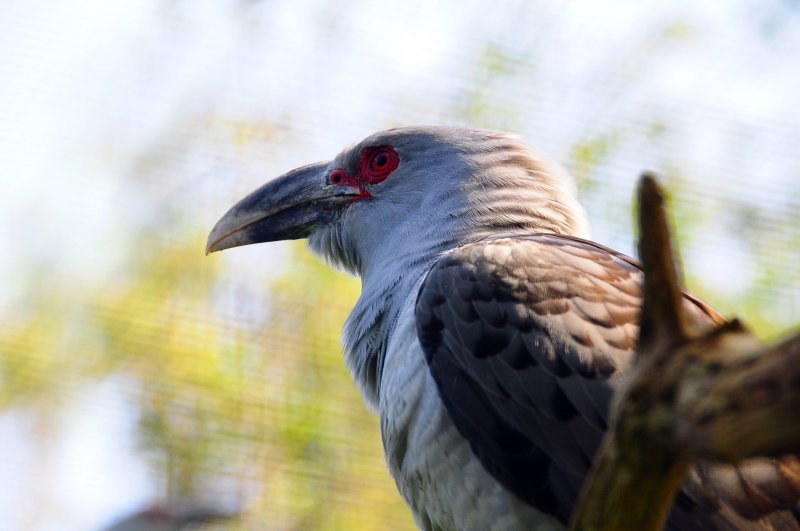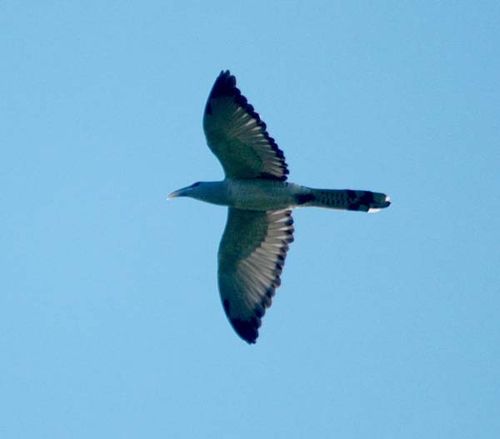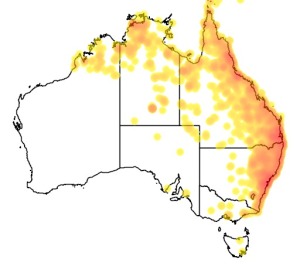Colours
Distinguishing features
The bill is bicoloured, with a grey base becoming straw-coloured at the tip. The bill is large and slightly curved.
The plumage of the adult is pale grey on the head, chest, belly and back, becoming paler and barred lower down on the belly. The wings are darker grey with dark tips on the feathers. The tail is dark grey on top and barred underneath with a black band and white tip at the end. The feet and legs are black, and the eye is surrounded by prominent red skin.
It is a strong flier, with a distinctive, almost hawk-like cruciform flight silhouette. In flight the wingspan is around 1 m, with the wings held stiffly.
There is some sexual dimorphism in both plumage and dimensions, the female having a smaller bill and paler, more barred undersides.
The juvenile is similar to the adult but has pale tips to the feathers of the wings, and the rest of the plumage is buff instead of pale grey. The bill is less massive and dirty pink in colour, and the skin around the eye is not red. (Wikipedia)
Size
- From 58 cm to 66 cm (Length of specimen)
Wingspan
- Up to 110 cm
Synonyms
Distribution
Distribution and habitat preferences
It has a widespread distribution across northern and eastern Australia, New Guinea, the Bismarck Archipelago, and the islands of eastern Indonesia as far west as Sulawesi. The species is a permanent resident in the Bismarck Archipelago, Flores and Sulawesi. Elsewhere within its range it is migratory. Birds breeding in Australia range from north eastern West Australia through the Northern Territory and Queensland down into eastern New South Wales as far as Sydney. A few stragglers reach the eastern tip of Victoria, but are not thought to breed there. Vagrant birds have reached New Zealand and New Caledonia.
After the breeding season, in March and April, birds breeding in Australia begin to migrate northwards to their wintering grounds in New Guinea and Indonesia. Birds breeding in New South Wales begin leaving earlier, in February and March.
The migration route is across the Torres Strait, travelling individually or in small groups. From New Guinea they migrate across the nearby islands as far as Timor and the Moluccas. It is not known if the species breeds in New Guinea, as some birds are present there all year. Migrating birds begin to return to Australia in October. (Wikipedia)
Audio recordings
Behaviour
They are brood parasites; instead of raising their own young, they lay eggs in the nests of other birds. They are thought to form pair bonds for the duration of a breeding season. Their mating behaviour has been described as involving calling and gift-giving, with the male presenting items of food such as insects to the female. Pairs also work together in order to aid the laying of eggs in host nests; the male will fly over the nest in order to provoke the nest occupants into a mobbing response, whereupon the female will slip into the nest and lay an egg. Alternatively the pair may work together by attacking an incubating bird, driving it off the nest and allowing the female to lay.
The host species varies depending on the location; the most commonly targeted hosts are ravens, currawongs, butcherbirds and Australian Magpies. (Wikipedia)
Diet
Unusually for cuckoos, which take insect prey, but like the closely related koels, fruit forms a major part of the diet of Channel-billed Cuckoo. Fruits taken include those of several species of Ficus figs, the fruits of trees in the family Loranthaceae as well as the fruits of the introduced Black Mulberry.
Also taken are insects, including beetles, butterflies and grasshoppers, and the nestlings and eggs of birds, including Apostlebird, Magpie-lark and Noisy Miner. Birds typically feed in the canopy of large trees, sometimes in groups and occasionally with other fruit eating birds such as Australasian Figbirds and Cuckoo-shrikes. (Wikipedia)



